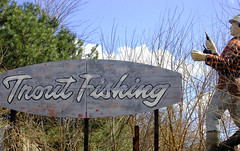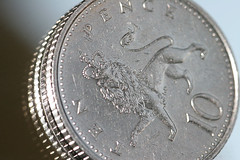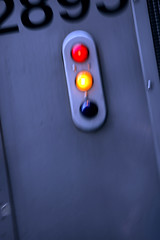
I saw Sam Rockwell in Moon over the summer. My intention was to escape the emotional world I was suspended in, if only briefly, attending to the bedside of my grandmother who had fallen and injured her brain in a way that could not be repaired. It was intended to be a respite from sitting with her while she died.
Instead, it managed to extend the desolate, zero gravity feeling that pervaded those weeks in July, but I didn't object. We read, we attend theater, we watch movies, we tell stories so that we, each of us, feel a little bit less alone. Moon did that for me just then, just the way I needed it to.
It also prompted me to send the World's Best Mechanical Engineer an email asking him 1) have you seen Moon and 2) when you do, let me know what you think of those Helium 3 Harvesters.
The World's Best Mechanical Engineer designs and deploys agricultural harvesters (currently in the works: a machine that harvests romaine lettuce with water jets -- video on youtube) so I figured he would have something interesting to say about it. His guest post series, The World's Best Mechanical Engineer Explains it all For You, is also some of the most heavily searched out and retrieved content on this blog, so I asked if he would want to do a guest post on detritus as well.
He was kind enough to agree.
Video: Moon Movie Trailer
The World's Best Mechanical Engineer on the feasibility of Helium 3 Harvesters (as portrayed in the movie Moon)
I watched "Moon" on video the other day, and suttonhoo asked my technical opinion of the Helium 3 harvesting machine in the movie.
Roughly I would say the size of the machine was 25 feet wide, 40 feet long, and 25 feet high. The harvester had wide spindly arms extending off each side that were upsetting the surface of the moon. The exact details of that might have been clearer on the big screen, on the small screen it looked like either some form of high pressure jet or laser. The machine ran autonomously on a huge pair of tracks.
The track drive is where the problems start with this machine. Track drives have three defining traits: they are high maintenance, they are heavy, and they give great flotation in soft conditions. The first two negatives generally outway the last positive trait. That's why your Honda has wheels instead of a pair of tracks.
In the context of the moon, high maintenance is a gigantic liability since there's only a single maintenance guy for a fleet of four harvesters. And maintenance is difficult in a vacuum, dangerous work for a single maintenance man. Helium 3 is going to be a very expensive product, and downtime in your operation will be lost millions. Compared to a wheel drive, track drives are in my experience roughly 5 times more maintenance intensive than wheel drives.
The huge weight of a track drive in and of itself is not much of a liability on the moon, except that those tracks have to be fabricated somewhere. If they are fabricated on earth, the cost of hoisting them into space would be probably prohibitive. So we'd have to assume that they'd be fabricated on the moon. But everything you do on the moon is expensive and time consuming. Tracks are a costly design proposition in both the earthly and lunar context.
This leaves us with the one compelling advantage of track drive: flotation. When NASA first landed on the moon they were afraid that there may be many feet of unpacked dust on the moon's surface, enough to swallow the entire lunar lander. In practice, however, the surface of the moon did not threaten to swallow any of the landers or men that landed there. Undoubtedly this was in part due to the moon's low gravity, about 1/6th of earth's. A typical car tire puts about 35-50 psi pressure on the ground.
A typical track drive applies 5-10 psi of ground pressure on earth. But a car tire on the moon, would only apply 6-8 psi of pressure to the moon's surface (with the same amount of tire squash). Effectively a wheeled vehicle on the moon would achieve flotation comparable to a track drive on earth. A track drive would be an expensive and unreliable overkill. If there were flotation concerns, a six wheel drive would be much more compelling. Six wheel drive would be lower maintenance, and allow for lifting a damaged wheel or suspension without stopping. Harvesting could continue until repairs could be scheduled or parts were available, allowing for minimal downtime.
The second problem with the Helium 3 harvester involves the scarcity of Helium 3. In spite of what the taikonauts may want you to believe, it takes a huge amount of lunar material to produce a pound of He3. The concentration of He3 on the moon is roughly .01 parts per million. Any harvester would have to process enormous quantities of lunar material in order to produce a trickle of He3.
I'd expect a harvester to have a huge scraper on front delivering surface material into the machine, and for it to eject over 99.99999% of the material as probably an extremely fine powder. It just didn't appear that nearly enough material was being handled to produce an economically attractive quatity of He3. I will acknowledge, however, the possibly that the lasers/high pressure jet device on the fronts of the machine were extracting the He3 using some futuristic technology. But if so, why were there rocks flying all over the place?
On a more political note, the lunar corp astronauts and employees probably should have been Chinese. Nasa was supposedly returning to the moon in this decade, but it appears that funding for that program will not exist. In fact the U.S. will soon lack any kind of lifter for astronauts, and we'll actually be buying astronauts tickets on Russian rockets. Not that I mean to disparage the Russian space program, they build the most reliable rockets in the world. It just seems a shame that with both the U.S. and Russia's venerable space programs, the real Lunar Corp logo may very well be in Chinese.


































